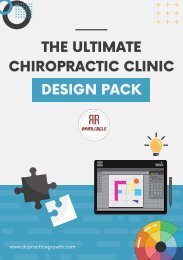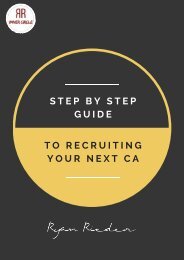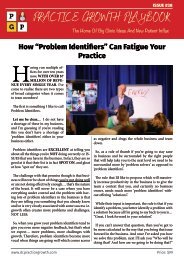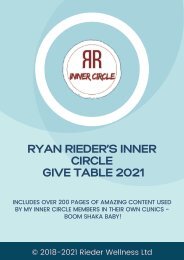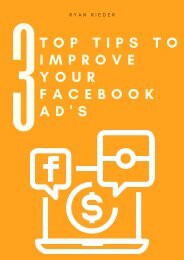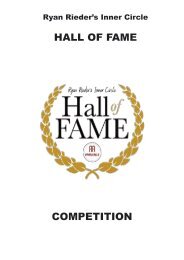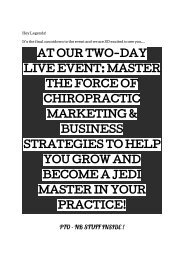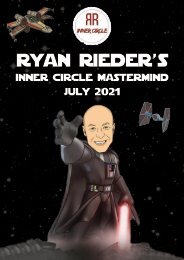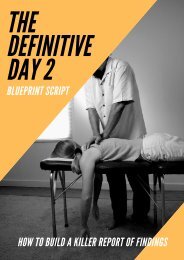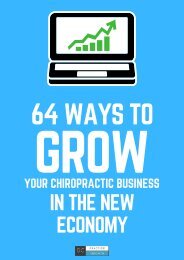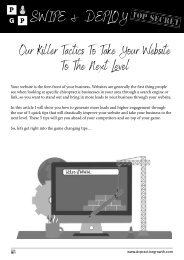A-Z Of Email Marketing
Create successful ePaper yourself
Turn your PDF publications into a flip-book with our unique Google optimized e-Paper software.
What Makes an <strong>Email</strong> “Junk”?<br />
The A to Z of <strong>Email</strong> <strong>Marketing</strong><br />
Copywriting is such an underrated skill that is so valuable to everything we do in the world of<br />
marketing. This is especially true when it comes to writing an email. <strong>Email</strong>s have always<br />
been a strong and empowering way of getting your message across to your audience. In our<br />
society today, we may feel as if our electronic mail communications will be lost in a sea of<br />
Facebook status updates, but statistics show that email marketing is still the strongest media<br />
to advertise and converse through. 81% of businesses still use emails as their primary<br />
customer acquisition channel and for their client retention. That’s a remarkable statistic<br />
considering there’s such a big stigma surrounding the competency of emails, but they are<br />
very powerful and can give you great results…if used in the correct way.<br />
There is one particular skill that you need to master before you can sit back and relax with<br />
your emails, and that’s copywriting. For those who may be unfamiliar with the terminology,<br />
copywriting is a marketer’s way of creating an emotional connection with an audience<br />
through written communication, whether that be through email, blogs or social posts. The<br />
most important thing I can say to you when it comes to writing is that whenever you are<br />
talking about your product in any form of your copy, it is vital that you treat your<br />
product as a service.<br />
“Sell a good night’s sleep…not the mattress”<br />
Now, email copywriting is very different to what you’d use on Facebook for instance. There<br />
are a set of “commandments” that are vital to live by to send the most effective emails to<br />
your clients.<br />
1. Subject line<br />
2. Use of personalisation<br />
3. Bullet points<br />
4. P.s’s<br />
5. Actionable language<br />
6. Relevancy<br />
7. Benefits vs. Features<br />
With this set of rules in your writing arsenal, you will be composing emails with higher open<br />
rates and opt-in rates before you can say “you’ve got mail”…<br />
Subject Lines: Just like attending a job interview or going on a date with someone you met<br />
online – first impressions are EVERYTHING. And that is especially the case with emails.<br />
The subject line is the first thing any recipient will read on an email and it needs to stand out.<br />
If it isn’t relevant or interesting, it will just be scrolled past and won’t inspire your list to take<br />
action. The ability to write an interesting subject line can be challenging and hard to think of.<br />
When coming up with your engaging “title”, it’s important to leverage human desires and<br />
curiosities – this is where a question works exceptionally well. <strong>Email</strong>s that feature a question<br />
in the subject line have a 60% higher open rate than those that don’t. Another way of<br />
increasing interest is by using strong and exciting verbs to grab your recipient’s attention and<br />
to bring drama to your emails. If that doesn’t work for you, there’s nothing wrong with being<br />
a little provocative! Try providing a subject line with a slightly controversial message, if<br />
anything, you’ll arouse interest and curiosity within the recipient, urging them to read on.<br />
© 2018-2021 Rieder Wellness Ltd
Research has shown that shorter subject lines receive a better open rate than those with longer<br />
ones. This is likely due to where most recipients are consuming their emails – their mobile<br />
phones. If the subject line is too long, it may look bad on a mobile device and be cut off at an<br />
important point, meaning they will not get the whole story and won’t want to click. It’s also<br />
great to use what I like to call “action phrases”, these are lines such as ‘act now’ or ‘don’t<br />
miss out’. They give the recipient an idea of what you want them to do, before they even<br />
open the email. A great extra tip for your subject lines is personalisation, it’s refreshing for<br />
people to receive an email that has their name in the subject line, it stops them feeling like<br />
they’re just another email in a list of thousands.<br />
Use of Personalisation: <strong>Email</strong>s that are well segmented often have higher engagement levels<br />
with their open rate and opt-in rate than those that don’t. According to a recent study, emails<br />
that are targeted generate 58% higher revenue. This isn’t surprising when you consider that<br />
the more segmented your list is, the more freedom you have to personalise it and give more<br />
relevant content to the reader. You want to enable yourself to talk to a more direct audience<br />
to get a clearer message across. Just think…would you talk the same to a client who’s only<br />
been in for two adjustments, as you would a client who’s not been in to see you for 8 months,<br />
but has spent £1000. You wouldn’t, right? You ultimately know that the latter client is more<br />
valuable and you’d need to be clever about how you invite them back in to your clinic. The<br />
most important thing to remember with personalisation is that the reader wants to feel like the<br />
focus is on them and what’s in it for them, rather than a generalisation of the benefits. 75% of<br />
customers say that they’re more likely to do business with a company that uses their name,<br />
makes recommendations based on their past experiences or knows their past interactions with<br />
the products/service.<br />
Bullet Points: These are a great way to engage your reader when they are consuming your<br />
email. If you have a long form of copy, with lots of plain paragraphs, the reader can get very<br />
bored and decide to just give up on reading your email. Bullets points are a fantastic way of<br />
breaking up your text and highlighting important points you want to make sure the recipient<br />
has read. Bullet points are also great for content-rich emails, like if you wanted to state the<br />
“top 5 tips for a healthy Christmas” or the “10 facts you need to know about sciatica”.<br />
Bulleted content should be introduced with short, catchy phrasing that draws the eye of the<br />
reader. They don’t need to tell the reader what every section is about, but they act as<br />
summarisers or a sort of contents page. The thought process to have in mind is “if the reader<br />
only read the bullet points, could they get enough information to understand the purpose<br />
of the email…?”<br />
The Post Script: Now, who doesn’t love a “p.s.” at the end of an email, that last little bit of<br />
information just before you head off, that actually ends up being the most important line in<br />
the email! Well if you’ve never felt like that before, you should be, that’s the whole point of<br />
the post script line. The best reasons to use them are to hook the recipient with a<br />
compelling link, to make a final plea to take up your offer, to create an element of<br />
urgency, to provide bonus information or a further offer and lastly, to ask if they’d like to<br />
share a testimonial (this is a great one). Ask yourself…“What’s the beginning, middle and<br />
end?”, just like in any story. The beginning is always the subject line, the middle is your<br />
compelling offer and reasons to why it’s different from all the others, and then lastly is your<br />
end – the almighty “p.s.”.<br />
P.s. The final thought.<br />
© 2018-2021 Rieder Wellness Ltd
Speak Actionable Language: Whenever you’re writing an email to your list, you are more<br />
often than not, prompting your reader to take some form of action. Getting your recipient to<br />
take action on a certain thing is usually down to two things: engagement and revenue. I really<br />
think that if you’re not prompting some form of action in every email you send, no matter<br />
how small, you’re doing something wrong. We have to remember, people aren’t that clever in<br />
the grand scheme of things and they need to be told what to do. So when you want to get<br />
them to follow a link or click a button, you have to instruct them as to where, why and<br />
how, multiple times throughout your email copy. <strong>Email</strong> copywriting is one of the more<br />
difficult forms of copy, as unlike a Facebook advert, you are having to prompt for two<br />
actions to be taken: they need to open your email (first action) and then click through to<br />
whatever you’ve placed in the email (second action). That’s why every single cog in the<br />
email copy is integral to its success, from the subject line to the post scripts. Using<br />
“actionable” language doesn’t always mean using strong verbs like “take”, “buy” or<br />
“download” to direct their behaviour, you just need to use phrases that point them in the right<br />
direction. It’s good to focus more on what you want the recipient to do with the information<br />
in the email, not what to do once they’ve opened it.<br />
It’s All Relevant: Just like in an email subject line, your email copy should seek to establish<br />
relevancy through personalisation. It takes more than just a name in the email header to<br />
warrant a reason for them to be receiving an email from you, so this is where it’s great to<br />
explain just how you know each other. For example…<br />
“Hi there ~Contact.FirstName~,<br />
It's been a long time since we last saw you at your local clinic for a treatment<br />
session and we miss you ~Contact.FirstName~...!<br />
Did you know you can book your next appointment with us now in less than a minute?<br />
You are overdue an appointment with us and we just wanted to remind you the importance<br />
of maintaining care to keep your body healthy, strong and aligned. You may feel like you<br />
are now pain-free but our care can not only help to reduce pain but also maintain your<br />
nervous system to ensure its keeping at its optimal potential.<br />
You can get your next check-up booked in with us now by simply clicking on the button<br />
below, we'd love to see you in our clinic soon.”<br />
The text above that is in red, straight away set’s the precedence of “this is why your being<br />
emailed”. Also, notice the sentence in blue, this is a hyperlinked actionable sentence, leading<br />
the reader to a link to book a provisional appointment, prompting them to be given a call to<br />
confirm their booking. The only reason this reader would receive this email is if they had not<br />
been in to see us for a while and it’s relevant to them as they’d know that they’ve not been in<br />
for a little while. Nonetheless, you must be relevant if you want your email to be opened.<br />
63% of people say that they’d think more positively of a company if it gave them more<br />
valuable, interesting and relevant content. You only have a few minutes, even seconds, to<br />
convince your reader that your email is worth their time, which is why establishing relevance<br />
is so important, meeting them at the right point in their journey. Sending the right email, at<br />
the right time, is such a vital part of email marketing.<br />
*Ding Ding* It’s Benefits Vs. Features: I put a question to you now...? How often have you<br />
received an email from a company with a lavish description about how great a product is,<br />
© 2018-2021 Rieder Wellness Ltd
with a call to action telling you must buy now? I bet it’s a lot, right? I mean, you may have<br />
even sent one yourself…? Too many emails nowadays focus too much on the features of a<br />
product or service that they’re trying to sell. The one statement that helps you think about<br />
how you should be getting your message across is simply:<br />
“That’s great for YOU, but how does this help ME?”<br />
That is what every customer says to themselves when they get an email like that. There’s a<br />
simple solution, ditch the pretentiousness and start focusing on the pure delight and value<br />
your customers will experience from using your product or service. What is that one thing<br />
your chiropractic adjustment will help them to solve? Put yourself in the shoes of the<br />
reader and consider their emotions and how they may be feeling or what they’re struggling<br />
with and what they might want to achieve. It really isn’t complicated.<br />
<strong>Email</strong> copywriting is just a mixture of pure art and science. There is a tried and tested<br />
formula that will push you in the right direction to succeed. You just have to add a bit of<br />
“you”, and dedicate yourself to write and improve at your copywriting, the words will come,<br />
you just need to take the action to begin writing them.<br />
So remember…<br />
• Be relevant<br />
• Give value<br />
• Be consistent<br />
• It’s good to test what works for you<br />
• Measure, measure, measure<br />
• The shorter, the better<br />
• Don’t be afraid to be bold, highlight a few key areas and don’t dodge the bullet<br />
(point)<br />
Dr. Ryan Rieder (DC)<br />
The Information provided by Rieder Wellness Ltd is for general informational and educational<br />
purposes only and should be used as a model or guideline to base your work on and tweak where<br />
necessary.<br />
You should not rely solely upon the material or information as a basis for making any business,<br />
legal or any other decisions, and should ensure that any information you use sits in line with your<br />
own /governmental current legislative guidelines and procedures.<br />
Rieder Wellness Ltd accepts no responsibility and any reliance you place on such material is<br />
therefore strictly at your own risk. All rights reserved, no part of this publication may be<br />
reproduced, distributed, sold or transmitted in any form or by any means, including photocopying.<br />
© 2018-2021 Rieder Wellness Ltd





